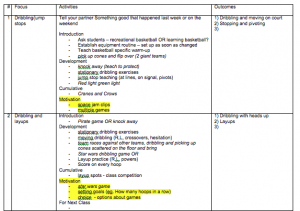Linking to Practice
My inquiry looks at the structures that I can control and the classroom environment and community I am creating in the classroom as a way to increase motivation in students. The focus of interest in my inquiry is taking the form of not just students’ personal interest, but through the structuring of the learning environment. While I will continue to attempt to facilitate situational interest through novel concepts and ideas, the focus is on the structuring of the whole environment and the connection between different overarching structures rather than just single component of lessons.
For my practicum, I am concentrating on structuring of the learning environment and on student motivation. I created a “motivation” column on my lesson and unit plans to implement during practicum with a checklist for multiple different motivators and ways of structuring the learning environment. In each of my unit plans I also included a list of general ways of increasing motivation and structuring the environment on each of my unit plans as way of ensuring that I try multiple different ways of getting at motivation. Each of my lessons will include some component that will work towards motivation through the structuring of the learning environment or by the content that is provided that day.
This column will assist me on staying on track with my goal of structuring the learning environment and activities towards an intrinsically motivated physical literacy environment. This will be especially helpful in the planning of my units and my lessons as it will help me recognize when I am not creating novel or exciting situations that might lead to student situational interest. By focusing on how I structure the environment towards creating a classroom community, I hope to facilitate confidence and competence and motivation in the students.

In practice, my inquiry is including a variety of types of activities and models of physical education. I am using Prithwi Raj Subramaniam’s list of “Ten Ways to Evoke Situational Interest in Physical Education” (2010) as a guide to my inquiry, which focuses on various ways to create an engaging class through novel and unique changes to the learning environment. Within my inquiry during practicum, among other items, I plan to include:
- A variety of physical education models (Sport Education, TGFU, Inventing Games)
- Unique hooks using videos, personal and funny stories
- A game at the start of each class
- Student choice and autonomy in activities and challenge
- Using instant enjoyment activities such as goofy games
- Using novel tasks including video analysis of skills and gameplay
To create situational interest, I will attempt to create novel situations through different learning experiences such as using student exploration to learn concepts. I am going to be presenting info, skills and games in new, constantly changing, and creative ways, as the way information is presented can often be as important as the actual activity. A teaching games for understanding (TGFU) approach will be the basis much of the class format. Through it, concepts will be taught in activities and games that would not be traditionally associated with that activity. The model and teaching methodologies I use will also change throughout my practicum. For example, I will be using the sport education model for one unit and an inventing games unit as another. I will utilize developmentally appropriate skill progressions to optimally challenge students as challenge has been shown to increase situational interest (Graham et al., 2010; Rink, 2010). Whenever possible, choice and autonomy will be given to students as even choice in trivial matters has been found to increase interest (Cordova & Lepper, 1996).
To create novel learning experiences, I am going to use a unique hook or warm up game at the start of my classes in the form of a short discussion, video-clips, or lead-in activities. I will also use scenarios and stories (imaginative and personal) to facilitate interest. For example, I may base games on fantasy situations and set the stage by role-playing as another persona to create unique fun learning situations.
Future Considerations and Applications
As I continue my inquiry, my question is becoming less focused on strictly the learning environment and more about how I can model behaviour and structure my teaching so that the students are as engaged as possible. I plan to try and use multiple methods of structuring the learning environment such as:
- Providing student choice and autonomy
- Optimally challenging students through developmentally appropriate progressions and options
- Structuring around a mastery environment
- Using situational interest as a catalyst
- Including students in the decision making
- Incorporating a variety of instructional approaches
- Utilizing instant enjoyment activities and novel task design
- Using Social Emotional Learning (SEL) practices
The future of my inquiry will continue looking at student motivation and structuring the learning environment. I will also look more into SEL and how creating a community within the classroom can increase motivation. I would like to integrate SEL activities and ideas throughout the class such as through random pairings for partners discussions community building and leadership activities. I would like to eventually allow students as much freedom in choice in physical education as possible. This includes choice in how and which skills are performed, the format of different games, and even the actual activities or units. For example, students should be given the choice of multiple different sport or leisure activities within a certain category. Students would choose a few activities from each of the categories (recreational activities, rhythmic, invasion games, net games, fielding, etc) so they still cover a multitude of areas.
I want to continue to look into how students can become self-sufficient, motivated confident individuals. I believe this will come about through a focus on creating caring, students who are invested with the students in their classes and classroom community.
 Follow
Follow